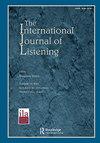The Known and Unknown About the Nature and Assessment of L2 Listening
Q1 Arts and Humanities
引用次数: 1
Abstract
ABSTRACT Although second language (L2) listening assessment has been the subject of much research interest in the past few decades, there remain a multitude of challenges facing the definition and operationalization of the L2 listening construct(s). Notably, the majority of L2 listening assessment studies are based upon the (implicit) assumption that listening is reducible to cognition and metacognition. This approach ignores emotional, neurophysiological, and sociocultural mechanisms underlying L2 listening. In this paper, the role of these mechanisms in L2 listening assessment is discussed and four gaps in understanding are explored: the nature of L2 listening, the interaction between listeners and the stimuli, the role of visuals, and authenticity in L2 listening assessments. Finally, a review of the papers published in the special issue is presented and recommendations for further research on L2 listening assessments are provided.关于二语听力的性质和评估的已知与未知
摘要尽管在过去的几十年里,二语听力评估一直是人们关注的主题,但二语听力结构的定义和操作仍然面临着许多挑战。值得注意的是,大多数二语听力评估研究都是基于(隐含的)假设,即听力可以归结为认知和元认知。这种方法忽略了二语听力的情感、神经生理学和社会文化机制。本文讨论了这些机制在二语听力评估中的作用,并探讨了理解中的四个差距:二语听力的本质、听众与刺激之间的互动、视觉的作用以及二语听力评价中的真实性。最后,对本刊发表的论文进行了综述,并对二语听力评估的进一步研究提出了建议。
本文章由计算机程序翻译,如有差异,请以英文原文为准。
求助全文
约1分钟内获得全文
求助全文
来源期刊

International Journal of Listening
Arts and Humanities-Language and Linguistics
CiteScore
4.70
自引率
0.00%
发文量
16
 求助内容:
求助内容: 应助结果提醒方式:
应助结果提醒方式:


